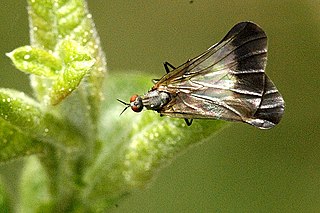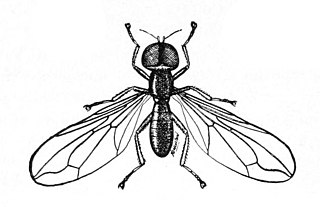
Pipunculidae is a family of flies (Diptera) commonly termed big-headed flies, a reference to the large (holoptic) eyes, which cover nearly the entire head. The family is found worldwide and more than 1300 species have been described.

Gabriel Strobl was an Austrian Roman Catholic priest and entomologist who specialised in Diptera.

Tachydromia is a genus of hybotid flies. It is widespread around the world, with species found essentially everywhere except the polar regions and some remote islands. They are not very diverse in East and Southeast Asia, or in Africa

Criorhina is a genus of hoverflies. Medium to large sized species, black or greenish black, with or without light ground markings mimicking bumblebees. The head is much flattened and broader than the thorax. The antennae are situated upon a prominent conical frontal process, The face is moderately produced below the eyes, downward or forward, in profile. The eyes are bare. The abdomen is elliptical or very short oval. Larvae found in rot holes or decaying hardwoods

Rhamphomyia is a genus of dance flies, in the fly family Empididae.

Milesia is a genus of very large hoverflies, which mimic social wasps. For example, the European species Milesia crabroniformis is a convincing mimic of the hornet species Vespa crabro. Milesia are predominantly Palaeotropical in distribution almost entirely Oriental.
Macquartia viridana is a European species of fly in the family Tachinidae.

Aphantorhaphopsis is a subgenus of flies in the family Tachinidae. Some consider this to be a subgenus of Siphona, most European workers seem content that this is a genus in its own right. They are known from the Palearctic, Afrotropical and Oriental regions.
Dorylomorpha is a genus of flies belonging to the family Pipunculidae.
Cephalops is a genus of flies belonging to the family Pipunculidae.

Pipunculus is a genus of flies belonging to the family Pipunculidae. The genus has a cosmopolitan distribution.
Sphegina spheginea is a species of hoverfly in the family Syrphidae.

Eudorylini is a tribe of big-headed flies.

Clistoabdominalis is a genus of flies in the family Pipunculidae.
Dasydorylas is a genus of flies in the family Pipunculidae.

Eudorylas is a genus of flies in the family Pipunculidae.
Eudorylas zonatus is a species of fly in the family Pipunculidae.
Tomosvaryella cilitarsis is a species of fly in the family Pipunculidae.
Pipunculus zugmayeriae is a species of fly in the family Pipunculidae.









